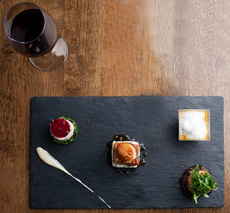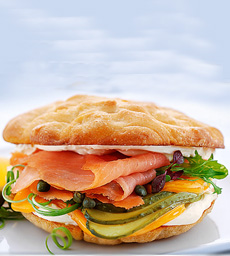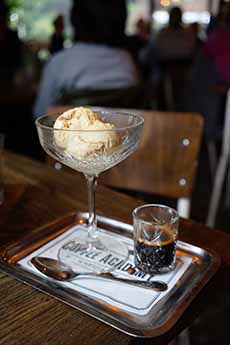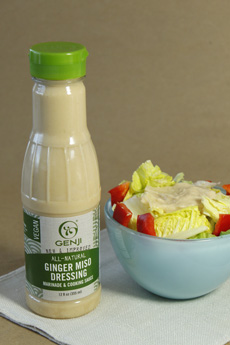
Genji Miso Dressing. Photo by Elvira Kalviste | © THE NIBBLE. |
|
Genji Inc. is a purveyor of sushi to 143 Whole Foods Markets and other food stores across the U.S. They supply the sushi bar and the staff who make the sushi.
Sushi bar customers loved the ginger miso salad dressing so much that the company bottled it.
Consumers can purchase it from the sushi case in two versions: regular Ginger Miso dressing and Spicy Ginger Miso dressing, which is pretty spicy (the heat level is like hot salsa—use it to get the heat-lovers in your family to eat more salad).
The tasty, vegan dressings are made from white miso, canola oil, and rice vinegar, flavored with onion, pickled ginger, soy sauce, and lemon juice. The miso adds a unique flavor not found in Western salad dressings—along with a pile of health benefits (more about them below). A two-tablespoon serving has 80 calories, 7g total fat, 0 cholesterol, 320 mg sodium, 3 total carbs, and 1 g protein.
The dressings are very thick. Some people love thick dressings, but your two-tablespoon portion size doesn’t go too far in coating a bowl of salad greens because it doesn’t “slide.”
So we diluted the miso dressing 1:1 with salad oil to get more coverage without using half the bottle.
> See the health benefits of miso below.
> The history of miso is also below.
|
|
WHAT IS MISO
Miso is a traditional Japanese seasoning made by fermenting rice, barley, and/or soybeans, with salt and koji kin, a natural fungus. The mixture ferments for three months to three years, producing an enzyme-rich food. The longer the fermentation, the higher the quality of the miso.
The result is a thick paste used to make sauces and spreads, to pickle vegetables and meats, and to mix with dashi, a soup stock, to become miso soup (misoshiru). Westerners can add it to beans, grains, pasta, seafood dishes, spreads and dips, stews, and numerous soups beyond misoshiru.
Here’s an entire book of delicious miso cookery. It also shows you how to make miso paste at home, from scratch.
The less ambitious among us can buy miso paste in the international section of supermarkets, in Asian markets and in health food stores.
There are different types of miso paste, based on whether they are made with bean malt, rice malt or wheat malt. Each type of miso paste can be made into either red miso or white miso, and different miso pastes are used in different recipes.
High in protein and rich in vitamins and minerals, miso is widely used in Japan, both in traditional and modern cooking. Different varieties of miso have been described as salty, sweet, earthy, fruity and savory, based on fermentation process, length of fermentation and added ingredients (rice or other grains can be added in addition to barley).
|
THE ANCIENT HISTORY OF MISO
While miso is strongly identified with Japan, the predecessor of today’s miso probably originated in China as a salt-fermented food called chiang. It was originally made with animal proteins—meat or fish.
Over time, soybeans were substituted for the animal proteins. The first written record of this is from Chimin Yaushu, who created what is perhaps the oldest agricultural encyclopedia in the world (written between 535 and 550 C.E.). He indicates that fermented soybean foods had been prepared for centuries.
Miso probably arrived in Japan with the introduction of Buddhism, in that same century. To use a modern expression, it was a big hit, and quickly became a staple of the Japanese diet.
All Japanese miso varieties are made with fermented soybeans, but there are broad district and regional differences based on local tradition and preferences.
|
|
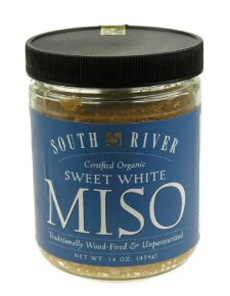
If you can’t find unpasteurized miso locally, you can buy it online. The South River line makes different varieties of miso (including barley, chickpea, and brown rice misos), all of which are certified organic. |
THE HEALTH BENEFITS OF MISO
Miso is a highly nutritious food. It is a “perfect protein,” containing all eight of the essential amino acids.
General health. Miso is low in fat and cholesterol-free. It contains three important antioxidant groups: isoflavones, estrogen-based antioxidants that fight hot flashes; saponins, phytochemicals that may reduce elevated cholesterol levels and may fight against breast, colon, prostate, and uterine cancers; and phytosterols, which also may be beneficial in lowering cholesterol levels.
Protein. The fermented soybeans create a high-quality protein that is easily digested.
Digestion. Miso aids in the digestion of other foods. Unpasteurized miso (there is also shelf-stable, pasteurized miso) contains natural digestive enzymes and lactic acid bacteria (the lactobacillus found in yogurt). Since these live organisms die at temperatures higher than 104°F, unpasteurized miso should never be cooked at high heat. For miso soup, the paste is stirred into the dashi toward the conclusion of cooking.
Detoxification. Zybicolin, an active ingredient in miso, has been found to be effective in detoxifying elements that are taken into the body through chemicals in the soil and food system, industrial pollution and radioactivity.
According to Japanese mythology, miso is a gift to mankind from the gods, to assure lasting happiness, health and longevity. We can’t make any guarantees, but we think you’ll like it.
CHECK OUT WHAT’S HAPPENING ON OUR HOME PAGE, THENIBBLE.COM.
|
|


